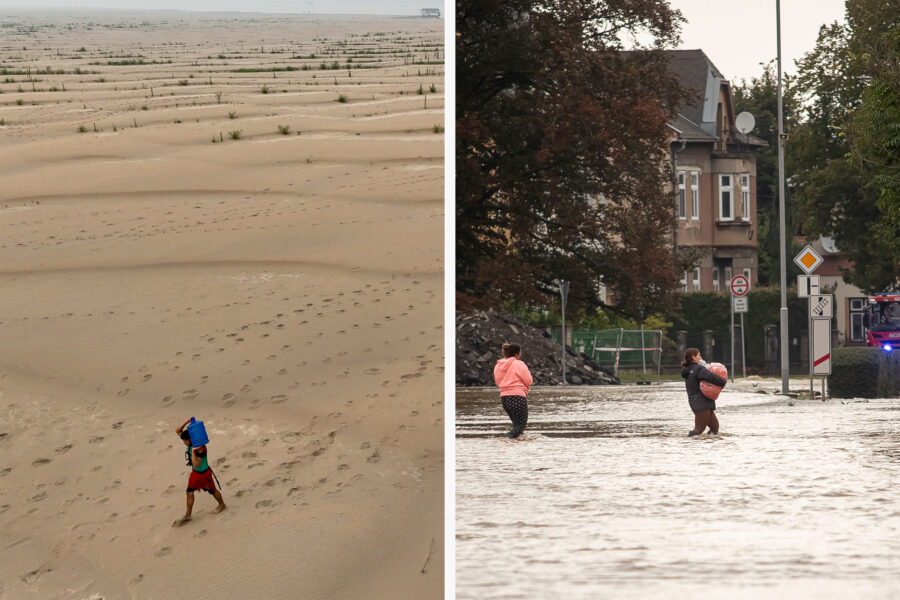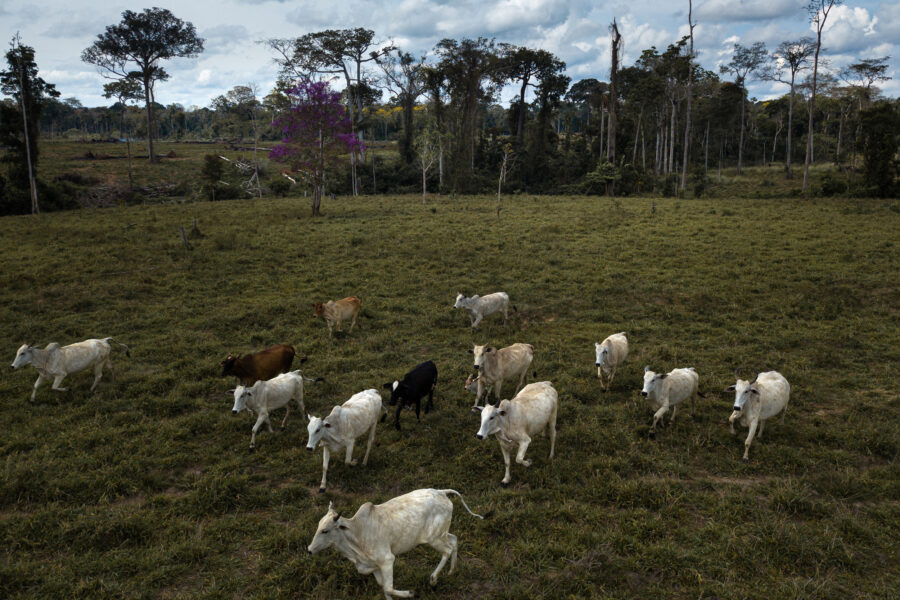The Key to Fix California’s Inadequate Water Storage? Put Water Underground, Scientists Say
A new University of California Riverside study on California agriculture and climate proposes a plan for new water capture, storage and distribution systems throughout California that will sustain agriculture and keep up with climate trajectories.
Available water for consumption is disappearing because of climate change and failing storage systems, leaving one of its top consumers—the agricultural industry—scrambling, the study concludes.
California’s agriculture sector uses about 40 percent of all the state’s water, or 80 percent of its consumed water. With less water available, agriculture must adjust. The study provides a pathway for the sector to do so.
The study, published last month in the Proceedings of the National Academy of Sciences, finds that groundwater aquifers have more storage potential than surface water reservoirs. So, instead of devoting decades to build more dams and reservoirs that are subject to evaporation and overflow, water should be diverted into these depleted aquifers below the Central Valley and the coastal plains.
Explore the latest news about what’s at stake for the climate during this election season.
Over the past 40 years, aquifers have been over pumped, meaning more water has been taken out than put back in. When aquifers become too depleted, the land can subside. “In some parts of the Central Valley, it’s been sinking a foot or two a year,” said Kurt Schwabe, a public policy professor at UC Riverside and co-author of the study. Land subsidence can cause infrastructure like buildings and highways to crack and degrade. It also harms the aquifer’s capacity to hold water and the health of the surrounding ecosystems.
Not only can replenishing groundwater aquifers limit these negative environmental impacts, but it can also bolster a water “savings account” during times of drought. When California lacks surface water, water usage shifts to groundwater stores.
But the big problem isn’t simply a quantity issue: “When I moved to California over 20 years ago, someone told me, ‘Don’t let people tell you there isn’t a lot of water in California because there is. The problem is that it’s just managed really poorly,” said Schwabe.
The drought-plagued state was just drenched by two wet seasons and atmospheric rivers, but its infrastructure failed to adequately store that excess water.
Think of it like a leaky roof. In the past, you could have stored rainwater seeping through your roof in a gallon bucket for five separate rain events. Now, you would need a five gallon bucket for just one rain event.
Although the amount of precipitation hasn’t changed much compared to historical rates, “climate change has typically reduced the number of rainfall events, but has made them much more intense,” said Schwabe.
Additionally, the climate crisis has led to high temperatures that evaporate surface waters before they can replenish and prevent rainfall from accumulating as snowpack, which has traditionally refilled reservoirs throughout the spring.
Like the gallon bucket, California’s too-small storage facilities and slowly absorbing landscape can no longer hold the water, leading to flash flood warnings and potentially useful water flowing back to the ocean.
For example, two winters’ worth of snow followed by intense heat created a flood risk in 2023. State officials decided to release water from Lake Oroville and other reservoirs across Southern California and the Central Valley. Although this helped prevent flooding and sent water downstream, many Californians were upset that the fresh water was being wasted. In attempts to reduce overflow releases, water agencies and irrigation districts made recharge basins to capture precipitation. But it wasn’t enough. Constant overpumping and a changing climate leave aquifers depleted to this day.
Their natural recharge process – precipitation accumulating as surface water that percolates through the soil to recharge groundwater aquifers – can also be disrupted by urbanization or impervious covers like pavement, said Bruk Berhanu, a senior researcher in water efficiency and reuse at the Pacific Institute.
The study suggests more managed aquifer recharge (MAR) infrastructure is needed to adequately catch large amounts of water in short time periods and avoid similar water-loss situations.
MAR is an intentional method of recharging aquifers, especially those at low levels. Already commonly implemented in California, MAR infrastructure includes conveyance structures that redistribute water to dehydrated locations, and injection—spraying water on land or, the more costly option, directly infusing water in wells.
Yet, to ensure an effective recharge of the aquifers, more monitoring and measurement is required. “Through 2014, growers were not required to monitor or report any withdraws or injections to aquifers,” said Schwabe.
Regardless, California has more monitoring practices than other states mainly because water availability is not as big of a concern elsewhere, said Berhanu. Monitoring standards vary by state and region. Regulations for urban areas differ from agricultural or industrial areas. Based on Berhanu’s work assessing the country’s volumetric potential for water use efficiency at the municipal level, he found that “there is no federal regulatory framework for monitoring or reporting. In a lot of cases, water supplies aren’t even metered.”
Even in areas that did have regulations, the reports were often infrequent or incomplete; the UC Riverside researchers are working on expanding the few accurate monitoring systems put in place in Southern California by proactive growers.
Additionally, the study proposes voluntary water markets where farmers with a surplus of water can trade it to another farmer in need. It’s a win-win process: the selling farmer makes extra profit and the other gets much-needed water. “With prices based on scarcity plus delivery costs, such a marketplace would have incentives for storage and efficient use,” Schwabe said in a press release.
Berhanu added that water trading markets can work in some areas but not in others; “it needs a very strong governance framework to make sure all of the players are playing according to the roles.” The process will need to have improved monitoring practices, transparent data, and clear external costs, he said. “The more decentralized you get with how these transactions are being made, it becomes very difficult to coordinate the overall watershed scale system benefits.”
The study also mentions the value of reusing wastewater. Historically, wastewater has been treated to an environmental safety standard then released into the ocean or groundwater system. Over time, natural processes will clean it. Instead of waiting for the environment to purify it, water treatment facilities can repurpose the wastewater for irrigation, commercial use, or recharging purposes.
As of 2023, water treatment plants can purify wastewater so well that people can drink it. “At some point, the water that we use will become someone else’s water for drinking or irrigation,” said Berhanu. Whether wastewater is for drinking or recharging aquifers, California plants are expanding their operations to include recycling methods so they can produce a sufficient supply.
“The overall volume of water in the world doesn’t really change. We need to shift our thinking from looking at how much water is available at one point of time to trying to better integrate our practices with the entire water cycle,” said Berhanu.
The study goes on to mention numerous efficiency-based and management solutions, like sustainable farming practices, land repurposing and desalination to help the agriculture industry adjust.
“Now is the time to think about possibilities and opportunities for collaboration across agriculture, municipalities, and the environment to invest in smart investments that capture more water and put it in the ground,” said Schwabe.
About This Story
Perhaps you noticed: This story, like all the news we publish, is free to read. That’s because Inside Climate News is a 501c3 nonprofit organization. We do not charge a subscription fee, lock our news behind a paywall, or clutter our website with ads. We make our news on climate and the environment freely available to you and anyone who wants it.
That’s not all. We also share our news for free with scores of other media organizations around the country. Many of them can’t afford to do environmental journalism of their own. We’ve built bureaus from coast to coast to report local stories, collaborate with local newsrooms and co-publish articles so that this vital work is shared as widely as possible.
Two of us launched ICN in 2007. Six years later we earned a Pulitzer Prize for National Reporting, and now we run the oldest and largest dedicated climate newsroom in the nation. We tell the story in all its complexity. We hold polluters accountable. We expose environmental injustice. We debunk misinformation. We scrutinize solutions and inspire action.
Donations from readers like you fund every aspect of what we do. If you don’t already, will you support our ongoing work, our reporting on the biggest crisis facing our planet, and help us reach even more readers in more places?
Please take a moment to make a tax-deductible donation. Every one of them makes a difference.
Thank you,
David Sassoon
Founder and Publisher
Vernon Loeb
Executive Editor
Share this article
Disclaimer: The copyright of this article belongs to the original author. Reposting this article is solely for the purpose of information dissemination and does not constitute any investment advice. If there is any infringement, please contact us immediately. We will make corrections or deletions as necessary. Thank you.








